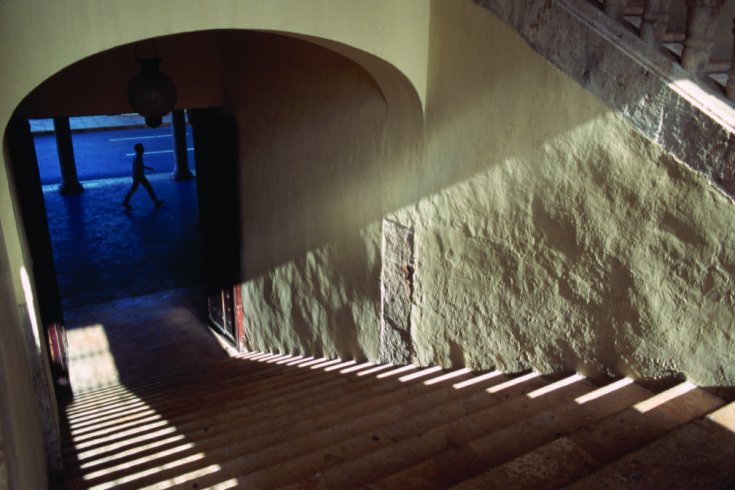
mérida—The best way to see Mérida, the heat-smitten capital of Mexico’s Yucatán state, is to stroll head down, staring at the sidewalk. Gouged, pitted, fissured, sometimes an asphalt-dotted spatter painting, sometimes a relief map of an unknown country, the sidewalks have made cement into a living material. (Beware the curbs, which may be hip-jolting drops.) Out by the mansions of Paseo de Montejo, sidewalks can be as broad as a street; near the municipal market, no wider than a hand span. Downtown, near the market, footfalls have buffed their dull surfaces to a glassy patina.
To look down at the sidewalks is to look up, and out, at the architecture and history of the city, and of the Yucatán Peninsula, a thick wedge of calcium carbonate lodged between the Caribbean and the Gulf of Mexico. By the 1930s, Mérida had been nicknamed the “Ciudad Blanca,” after its walls, washed white with lime solution from the Yucatán. The white remains today below the fraying pastels of the contemporary city, beneath the “Halloo!” calls of hammock shills, behind the “McPollo, Jr.” fast-food outlets and the market stalls, with their ironmongery, shrimp “cocktels,” and pumpkin-sized papayas. It is the same white that moves through the city in the guayabera, the handwoven thigh-length shirt that office workers wear, and the huipil, the embroidered dress Mayan women don when they want to look their best. Their clothes echo the surrounding cement, 60 percent lime that is mixed and churned into blocks and bags in kilns and silos on the city’s outskirts.
Out on a scrubby plateau near Mérida, white dust swirls, as no doubt it did some fifteen centuries ago while the Maya juggled sixty-five-ton blocks without benefit of the wheel, working to erect grandiose temples like those at Uxmal and Kabah. The layered, latticed stonework of their stepped limestone pyramids along this forty-kilometre hemline has made some observers think either the Egyptians or some peppy visitors from outer space must have had a hand in the Mayas’ work. Atop their temples, the Maya themselves carved in multiple the sardonic mask of Chaac, the rain god, whose grudging precipitation would instantly disappear into the Yucatán’s thin topsoil and porous bedrock. Chaac did his part; reservoirs, canals, and cisterns did the rest.
Into this arid terrain stomped Francisco de Montejo and his son, Spanish conquistadors who spent two decades subduing Maya warriors before founding Mérida in 1542. When the Montejos’ greed for land became too much for the Spanish royal court, the Franciscans took over, led by Bishop Diego da Landa, who herded the Maya into missions and cathedrals built with temple stones from the surrounding countryside, and burned every Mayan holy codex he could find, alarming even Pope Paul III with his zealotry. Forced conversions, land-grabs, famine, and epidemics became fixtures of the Mayan story, and Mexico’s independence, earned in 1810, did little to relieve their lot.
Compared to such adversities and adversaries, gringos like the intrepid diplomat and author John Lloyd Stephens and his illustrator, Frederick Catherwood, must have seemed angelic. Sometime around 1840, the pair stumbled upon the maze of temple ruins amid the tindery underbrush, then returned home to reveal them to the world. Exposed, restored, furnished with ticket booths and souvenir stands, the Mayan sites have today become a huge industry; the best-known of them, Chichén Itzá, which gets 3 million gawkers a year.
To get to Chichén Itzá, you must, as always, follow the concrete. Stop off midway along the six-hour road to Cancún—its mixed lime surface pounded by Volvo buses, their bolted-down TVs regaling passengers with Spanish-dubbed action flicks and Disney cartoons as black vultures, craving roadkill, circle overhead. Then, perhaps, carry on to Cancún, the mecca of modern Méridan concrete. In the early 1960s, the Mexican government began trucking in cement for the creation of a new Acapulco along this mangrove coastline, and Cancún’s Zona Hoteleria stands today as a phantasmagoria of sand-studded high-rises—Mayaland meets Club Med. The city has survived two hurricanes, a national depression, a peso crisis, and countless packaged visitors. Nothing can stop its condominium developments from unscrolling down the palmy “Mayan Riviera” coast. Got a spare $250,000? Buy a condo, reserve two weeks for your family’s holiday, and rent it out for the rest of the year at $1,000 a week.
Or, at less cost, you could be back in Mérida, watching at dusk, as thousands of shrieking, whistling blackbirds, perched in the treetops of the Plaza Major, fill the central square with sounds suggesting an avian construction site. Below them, light pours out onto the concrete from the big open doors of galleries, theatres, and palaces. Buses have ceased barging past the manic-depressive traffic lights of the narrow one-way streets, replaced now by café touts and trotting calesas (horse-drawn buggies).
Some of the streets are blocked off for guitarists, best-foot-forward Mayan dancers, and gawping tourists. Above them, on street-corner walls, enigmatic stencils of birds and animals recall the city’s history; its legacy of bewildered Maya arriving from the boondocks who couldn’t read names or numbers, instead using pictographs to set up appointments: “I’ll meet you at the corner of Iguana and Macaw.”
The next day, out in the bleached, slash-and-burn countryside, workers will quarry limestone to build and rebuild the peninsula, like those Maya who once built temples, then erected new structures over them in masonry and mortar. In Mérida, the sidewalks, slick and dark as if after rain, preserve the constants of the Yucatán condition: sand, cement, limestone. On these walkways, the inhabitants of the white city will hurry to work, pounding out the rhythm of past and present like an irregular heartbeat.




